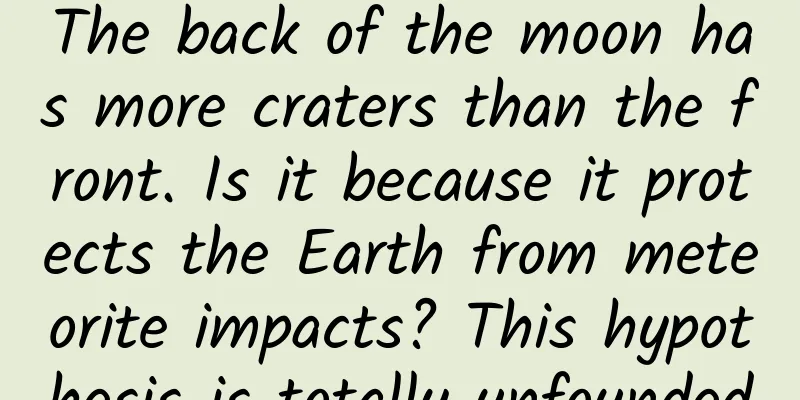The back of the moon has more craters than the front. Is it because it protects the Earth from meteorite impacts? This hypothesis is totally unfounded

|
The moon we see all year round has the same face. Do you know why? What does the other side of the moon look like? We can all see it. It has never changed. It is strange because the moon always has the same face when it is shown to the world. Although the lyrics say that the face of the moon is quietly changing, it seems that the face of the moon has never changed. So why is this? In fact, the reason is not complicated. It is because the earth and the moon are tidally locked. When an object in space revolves around another specific object, the time it takes for the object to rotate once is exactly the same as the time it revolves around the other celestial body. In this way, the other specific object always sees the same side of the object, or the object is revolved around. For the Earth-Moon system, the moon is always revolving around the Earth. The moon revolves around the Earth approximately once every 28 days, and the time for the moon to revolve around the Earth is exactly 28 days. In this way, we can only see one side of the moon on Earth, or we can say that the moon has only one side. Tidal locking of the Earth is a very common astronomical phenomenon. It often occurs between planets and their satellites, but sometimes it can also occur between other celestial bodies in space. It is precisely because of tidal locking that the moon seen by the ancients is the same as the moon we see today, and it will not change due to changes in geographical location. That is to say, the moon we see in the Southern Hemisphere, Northern Hemisphere, Eastern Hemisphere, and Western Hemisphere of the Earth is actually the same. So the question is, how can we know what the back of the moon looks like? It is not easy to see the back of the moon. We must fly to its back to see it. In 1959, humans flew to the back of the moon for the first time with the Soviet lunar exploration satellite and took some photos, giving us the opportunity to see its beauty. As the saying goes, you won’t know until you see it, you will be surprised. The back of the moon seen in the photos is very different from the front of the moon that we are used to. The most obvious is that it is covered with large and small craters, there are no large gray areas, and the brightness is also greater. Later, with the implementation of the Apollo program by the United States and the Chang'e lunar exploration project implemented by my country, there have been dozens of lunar exploration satellites that have orbited the moon, taking a large number of photos and measuring the surface terrain height, gravity field, surface temperature, mineral composition, etc., so that we can fully understand the overall picture of the moon. my country's Chang'e 4 lunar rover has landed directly on the back of the moon and has carried out exploration activities for more than three years, obtaining a large amount of scientific data. The picture comes from Tuchong.com These detection data show that the main differences between the back and front of the moon include the following aspects: First, the surface height difference is large. If you draw a circle with the average radius of the moon, then the terrain of most areas on the front side is lower than this circle, while the terrain line on the back side is higher than this circle. Second, the color is different. The overall color of the front side is darker. Those large areas with darker colors are called lunar seas, while the overall color of the back side is lighter. Third, the rock types and mineral compositions on the two sides are different. The back side is basically lighter in color, while the gray areas on the front side are all composed of dark basalt. Fourth, the number of impact craters on both sides, or the density difference is very obvious. The number of impact craters on the back side is obviously more than that on the front side, especially in the lunar sea area on the front side, where the number of impact craters is generally small. Fifth, the volcanic activities on the front and back sides are also very different. The basalts on the front side are all formed by volcanic eruptions. Most of the volcanic rocks on the moon are also on the front side of the moon, but there are very few on the back side. Sixth, the thickness of the lunar crust on the two sides is very different. The lunar crust is the outermost layer of the moon, which is the same as the earth's crust. Then the moon on the front side of the moon is obviously thinner than the back side. The above six points are the most obvious and proven differences between the front and back. So why is there such a big difference? In order to answer this question, scientists around the world have been conducting research for a long time. Here is a brief summary: The reason for the difference between the front and back of the moon can be traced back to the formation stage of the moon. The currently generally accepted view is that the moon was formed 4.5 billion years ago when the earth was hit by a celestial body the size of Mars, and the debris produced re-aggregated. At the beginning, the temperature of the moon was very high, and there may be magma rocks with a depth of hundreds of kilometers on it, covering the entire moon. As the moon cooled, these high-temperature magmas began to cool and began to crystallize different minerals. Then, the minerals with higher density in the clean area would sink, and the minerals with lower density would float upward, finally forming the lunar crust. At this time, the Earth-Moon system may have been locked, resulting in different gravitational forces on both sides, forming the different thickness of the moon we see now. But not everyone agrees with this view. Some people believe that a large impact event on the moon disrupted the normal lunar structure, including the different intensities of volcanic activity on the two sides, which is also related to the different thicknesses of the moon on both sides. So it is easier to break through the obstruction of the moon behind the front side of the moon, thus forming a large amount of volcanic rocks, while the moon on the back side is thick, and even if there is magma deep inside, it cannot erupt, so there are very few volcanoes. Two other frequently debated topics are that there are more impact craters on the back of the moon. Is it because the moon has blocked many impacts for the earth, or that the moon has protected the earth from a few impacts? In fact, this view has no basis. It means that the impacts on the front of the moon are not less than those on the back. In the geological units formed in the same period, there is no obvious difference in the density of impact craters. Only those covered by young volcanic rocks and the cross-sea area appear to be in a relatively small state. This is because there have been no early impact events. Second, there are more large impact basins on the moon on the front than on the back. Third, judging from the size of the two and the relative motion characteristics of the earth-moon system, the diameter of the moon is only more than 3,400 kilometers, about 1/4 of the earth, and the average distance between the earth and the moon is more than 380,000 kilometers, so meteorites may come from all directions. From this point of view, it is difficult for the two to protect each other, or the role they play is very small. Finally, it should be pointed out that we know far less about the back side of the moon than the front side. We also look forward to China's Chang'e 6 lunar exploration project returning samples from the back side of the moon as soon as possible, so as to unlock more secrets of the back side of the moon. This article is a work supported by Science Popularization China Starry Sky Project Author: Xiao Long Reviewer: Zuo Wei (Researcher at the National Astronomical Observatory of the Chinese Academy of Sciences) Produced by: China Association for Science and Technology Department of Science Popularization Producer: China Science and Technology Press Co., Ltd., Beijing Zhongke Xinghe Culture Media Co., Ltd. |
<<: Feeling sleepy and tired in spring? Please check out this spring tea drinking guide
>>: Want to get a taste of the laws of the universe? Then you have to take a bite of this vegetable
Recommend
Is the expanding universe really an illusion?
Traditionally, the standard model of cosmology ho...
Timely warning and comprehensive deployment in many places to actively respond to blizzards and cold waves
Affected by the cold wave, the temperature in the...
2022 CICC Automotive White Paper: Looking into the future and gaining insights into product changes
In 2022, the penetration rate of new energy vehic...
5 minutes to quickly build an iOS App
[[404179]] This article is reprinted from the WeC...
Interpretation of the 2014 Nobel Prize in Physics: A lighting revolution in the 21st century
On October 7, 2014, Beijing time, the Nobel Prize...
The domineering "little trumpet": The beautiful morning glory is actually a "foreigner"?
Speaking of invasive alien species, the most well...
Huge waves suddenly rose on the calm water surface. Is the "water monkey" making trouble again?
Above the quiet lake, a bird is wandering in the ...
Users complain about iOS 9 bugs and lags
[[149781]] At the previous Apple press conference...
6.18 How to use Taobao public domain traffic?
Although there is still a month to go until June ...
Has the Changsha epidemic been lifted in 2022? When will things return to normal? Attached is the latest news!
In recent times, Hunan has achieved remarkable res...
Elements and channels of product promotion plan!
The general promotion process is as follows: 1. M...
Beijing is issuing tens of millions of yuan worth of movie tickets. How to claim and use them?
Where can I get the movie tickets worth 10 millio...
Can the dog that has completed the experiment be happy if it is adopted?
Recently, a celebrity couple adopted a beagle and...
20 common usage examples of time and date libraries in Java 8
[[177393]] In addition to lambda expressions, str...
How to plan an excellent online event?
In Philip Kotler's book " Marketing Mana...









